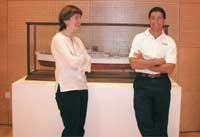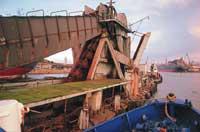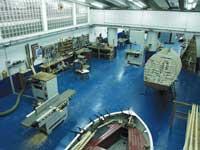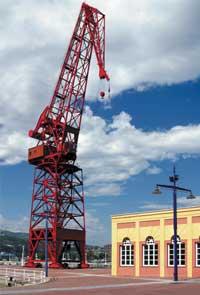"The goal is to spread maritime culture in our environment"
You have just opened the Museum. For what purpose?

The main objective is to spread the maritime culture in our environment. Bear in mind that in this place, in the old dock of the Euskalduna shipyards, we have an immense heritage that has been accumulating for centuries. Although it is true that in recent times it has been losing importance, this heritage is part of the identity of Bilbao, Bizkaia and Euskal Herria.
The aim is to preserve and disseminate this historical and cultural heritage, as well as to show the current reality. In fact, the sea continues to have a great weight in Euskal Herria, but we live it from another point of view: industrial activity continues and, at the same time, leisure activities have gained strength.
At the visit it was clear to us that you want to encourage people's participation, right?
Indeed. As you have seen, we want the museum to be totally open and inclusive. Therefore, one of the main parts and activities of the museum are the workshops. We cannot forget where we are. In fact, the museum is located in the place where was one of the most important shipyards, which has forced us to give a boost to shipbuilding, this time with an educational and cultural goal. Somehow, we want to adapt this activity to the reality we live and give people the opportunity to participate, either directly, participating in modeling workshops, carpentry or shipbuilding, or simply seeing how they work.

The workshops are an example of what we mean by a participatory museum, but we will also launch other activities to encourage visitors to participate in the past and in the future of the sea and boats.
On the other hand, it is evident that you have not chosen the location of the maritime museum...
Of course. In that we are in luck, because we are in the place that has had a wonderful past and at the same time Abandoibarra will have a great weight in the future of Bilbao, united by the past and the future. If even more things had been saved from the past, better several, but we cannot complain: The bomb booth, the Carola crane and the dams, one of them the XIX, have been saved. mid-century. It was the first dam for shipbuilding and civil repair in Spain. Therefore, we have received a rich heritage.
Sometimes we have had to perform various tasks of recovery of the heritage, such as the existence of this buried dike. When the ships began to grow, they did not enter the dam and had to make a wider one. We have excavated the old dam and recovered it for cultural use.
On the other hand, the advantage of being here is that prestigious museums surround us on topics that have nothing to do with us: Guggenheim Museum and Museum of Fine Arts. Next to the Euskalduna Congress Centre. We hope that the number of visitors will be high, as they are totally different and complementary museums. But, above all, this place has an enormous symbolic value, since those who worked here worked.
Who is the Maritime Museum for?
The museum is open to everyone, of course. However, it is mainly aimed at children and adults who have lived this experience. And it is that children have not known this aspect of the history of our people, and we believe that it is important to become aware of this reality, since it is part of their past. And those who have lived this story closely will feel identified. In one way or another, in a strip of age almost everyone has had someone related to the sea: his father, his grandfather, some uncle... Therefore, it is important to remember marine history, not only from the point of view of the identity of the people, but also from the point of view of humanity and feelings.

We have also prepared the museum for other visitors. To serve anyone who wants to delve into sea themes or museology, here will be a library. Anyone who wants to make a consultation can access without paying the entrance to the museum and we will provide the books and documents. Also, a classroom has been enabled for researchers who carry out theses or projects with complete peace of mind.
Workshops, library… what else does the museum offer and how is the space distributed?
The museum consists of two spaces, the exterior of 20,000 m 2 and the interior of 4,500 m 2 approximately. Inside, apart from the workshops, we have divided the space around three axes. The first of these is “Ria, seaport”, which explains the historical evolution of the estuary. In the second, entitled “Ria, mercado y taller” (Ria, market and workshop), the most relevant activities and economic and social reality are collected throughout history, and in the third, shipbuilding is exhibited, from the original shipbuilding in wood to the present. All in the building under the bridge.
But perhaps the outer space is the most singular. In fact, the boats of our collection are located in the three dikes of the old shipyard. Visitors can go down to the dikes and access the containers. Inside each boat will explain the work done in this type of container, as well as the way of life of those who worked there.

In addition, outside we have the Carola crane and the pump booth and other elements such as buoys, anchors... In principle, although the space for temporary exhibitions is included, if at some point more space is needed, an exhibition can also be placed outside.
Therefore, in addition to the permanent exhibition, you intend to organize temporary exhibitions...
Yes. We have a very good relationship with other museums of this type, and we intend to make joint projects, not only to exchange or share elements of our collections, but also to carry out other projects.
In Euskal Herria there are other maritime museums such as Bermeo, San Sebastian, Plentzia, San Sebastian Aquarium... But they are otherwise. In the Basque Country, the first of its kind is ours, so it is very important that we relate to other museums in other countries.
The Ría Maritime Museum of Bilbao participates in the eMarCon project. The name is the acronym for Electronic Content Maritime Culture, a project funded by the European Commission. The aim is to bring together geographically remote museums and their visitors. To do this, they plan to create software that allows virtual exhibitions through the Internet. In addition, having the same database, they will share the digital maritime heritage. This project involves nine entities from seven European countries. Among them are four museums: Bremerhaven Maritime Museum in Germany, Lisbon, Gdansk in Poland and Bilbao. In addition, the group consists of academic and work institutions in computer science and new technologies. However, the desire of all is that over time more museums are collected and a complete network is created. For more information click here . |
Buletina
Bidali zure helbide elektronikoa eta jaso asteroko buletina zure sarrera-ontzian











